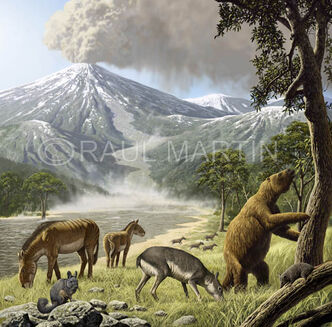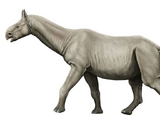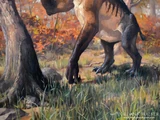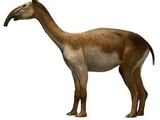Mammals (Linnaeus, 1758) are a group of endothermic animals characterized by hair/fur, and providing their young with milk for nutrititon, from sophisticated milk glands.

A depiction of some Prehistoric Mammals
Mammal Origins
Mammals first evolved around 220 million years ago, during the Late Triassic period, at around the same time as the dinosaurs. They evolved from a group of synapsids known as therapsids, or "mammal-like reptiles", which were characterized by sharing both reptiles and mammalian qualities. Mammals stayed small throughout the Mesozoic, although some, such as Didelphodon, could grow to the size of cats. But then, with the K-T Extinction event event, which wiped out the poor dinosaurs, mammals exploded into the niches the dinosaurs left vacant. Although, for a short time, Terror Birds, such as Diatryma, took on the roles of the extinct theropods, they were soon ousted by faster, more efficient mammalian predators, such as Hyaenodon. Mammals have continued to flourish to this day, being considered the dominant order of life.
Whatever the climate whatever the habitat mammals were adapted to these new environments until they were the biggest such as Indricotherium, fiercest, such as Entelodonts and most spectacular animals on the planet such as Mammoths. They even took to the seas like Basilosaurus and even the air likeIcaronycteris. Then around 4 million years ago our earliest ape-like ancestor evolved called Australopithecus which came down from the trees and walked upright. Finally in the ice age evolved new hairy mammals such as Mammoths and Woolly Rhinos. Mammoths were one of the most awesome mammals of all and they evolved into powerful killers like the famous sabre-toothed cat Smilodon.
-

Atlas Bear -

Paraceratherium -

Sinotherium -

Elasmotherium -

Chalicotherium -

Macrauchenia -

Entelodon -

Embolotherium
All items (229)
- Cadurcodon
- Camelops
-
Campanorco
-
Category:Caniformia
-
Category:Carnivora
-
Carnute Elk
- Carpathian wisent
- Casatia
- Caucasian moose
- Caucasian wisent
- Cebu Tamaraw
- Cebu warty pig
-
Category:Cenozoic mammals
- Ceratotherium mauritanicum
- Ceratotherium neumayri
-
Cervalces
-
Category:Cetacea
- Chalicotherium
- Chasmaporthetes
- Chilihueque
- Chilotherium
-
Category:Chiroptera
- Climacoceras
- Creodonta
- Cypretherium
- Harrington's mountain goat
- Hayoceros
- Helladotherium
- Hemiauchenia
- Heteromeryx
- Higgs Bison
- Hipparion
- Hippidion
- Hippohyus
- Hippopotamus antiquus
- Hippopotamus behemoth
- Hippopotamus gorgops
- Hippotherium
-
Hominidae
- Homo longi
-
Honanotherium
- Hoplophoneus
-
Category:Horses
-
Category:Humans
- Hyracotherium
-
Category:Hyraxes
- Pachyrukhos
- Palaeogiraffa
- Palaeolama
- Paraceratherium
- Paraentelodon
- Paratoceras
- Patagomaia
- Patagorhynchus
- Pelorovis
- Perissodactyla
-
Category:Perissodactyla
- Perucetus
-
Phasmatonycteris
-
Category:Pholidota
- Pleistocene megafauna
-
Category:Plesiadapiformes
- Pliohippus
-
Poabromylus
-
Category:Prehistoric Park Creatures
-
Category:Primates
-
Category:Proboscidea
- Proboscidipparion
- Procamelus
- Proentelodon
- Progiraffa
- Prolibytherium
- Propalaeomeryx
- Propotamochoerus
- Prosimians
- Prosynthetoceras
- Protoceras
- Protoryx
- Protovis himalayensis
-
Protungulatum
- Pseudoprotoceras




















































































































































